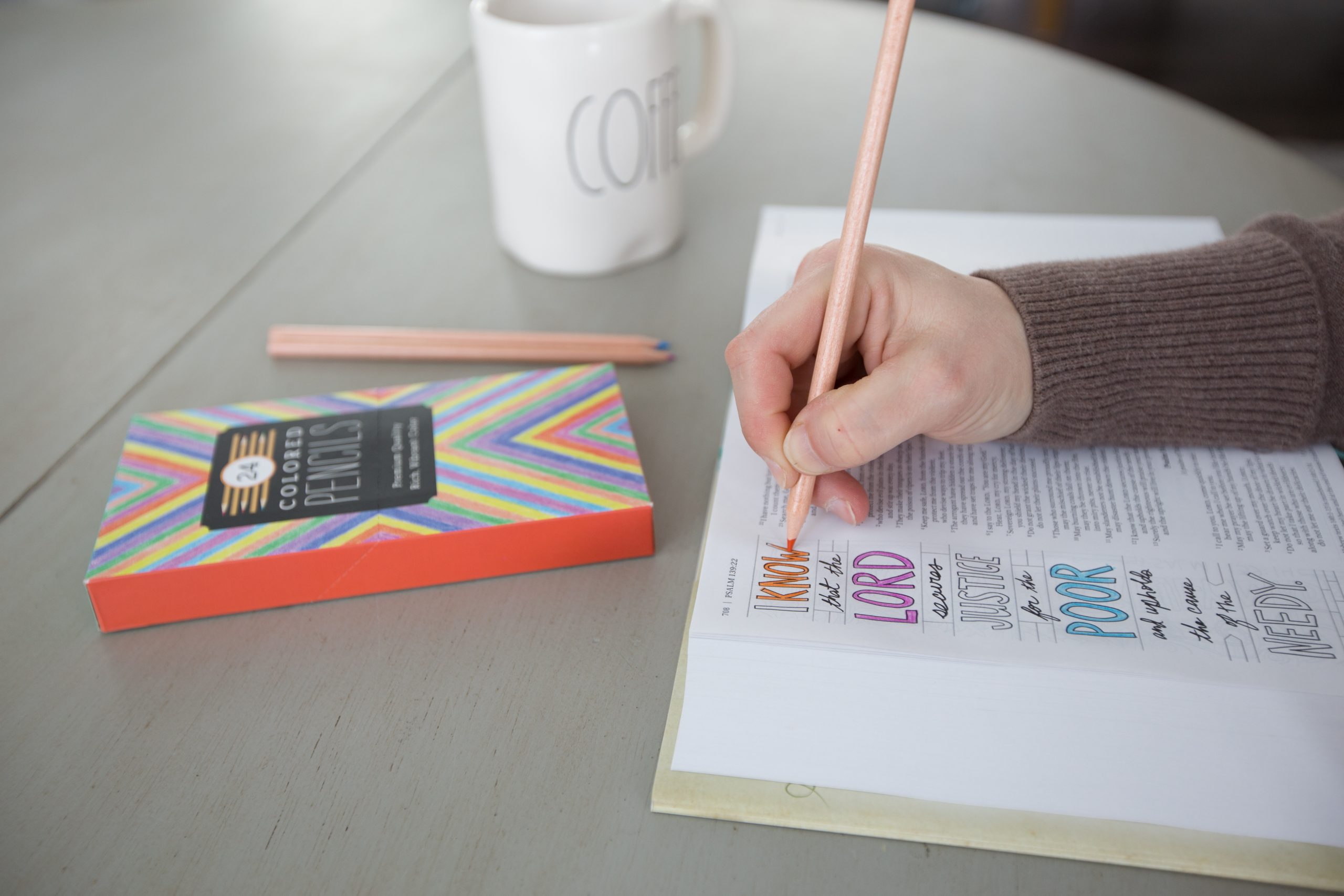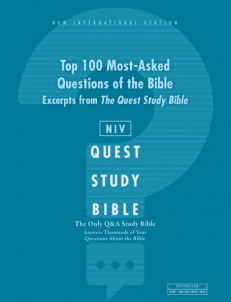
How to Bible Journal
As the writer of Hebrews tells us, God’s Word is “alive and active. Sharper than any double-edged sword, it penetrates even to dividing soul and spirit, joints and marrow; it judges the thoughts and attitudes of the heart” (Hebrews 4:12). So how do we put that power to work in our lives?
Obviously, reading our Bibles is important, but it’s easy to read passively and forget about it as soon as we put it down. We need to get in there and aggressively interact with Scripture, meditate on it, and consider its implications.
Memorization is another critical Scriptural discipline. This gets God’s words off the page and into our hearts. But it’s easy for us to memorize Scripture as an intellectual exercise, without letting it touch our will and imagination.
Finding new ways to interact with God’s Word helps to break us out of our ruts. For instance, praying Scripture can equip us to think about the Bible as an extension of our relationship with God. As a discipline, praying Scripture can help us see ourselves as more than receivers of Scripture, but participants in God’s story.
Bible journaling is another discipline that can revitalize your time in the Word—especially if you’re a highly creative person.
What is Bible Journaling?
Many of us have a grandparent with a well-loved Bible. It’s dog-eared from years of reading, and no matter where you open it, you find handwritten notes, prayer requests, highlights, and underlines. This is a form of Bible journaling.
Bible journaling is simply about reading your Bible devotionally and taking time to respond to the insights you receive. For many, this means spending time exercising their creativity by responding to God’s Word artistically. If you scroll through Pinterest, you’ll find a lot of gorgeous examples of artistic Bible journaling.
But you don’t have to be a professional artist to take up Bible journaling. You just have to want a new way to engage with God’s Word at a pace that allows you to pause, reflect, and respond to the wisdom you’re receiving.
This can be done with a graphic representation of the Scripture you’re reading, but it can also be done by highlighting key words, writing down next steps, or making note of areas that need prayer. Ultimately, you want to record what God communicates to you in your reading so that you can more faithfully meditate upon and apply his Word.
You Can Write in the Bible?!
Sometimes when you’re talking about scriptural study with new believers, they’re shocked at the idea that someone would write in their Bible. They hear the words “Holy Bible” and worry that writing in the Bible is somehow disrespectful or wrong.
While God’s Word is incredibly important to Christians, we don’t worship the Bible. We want to interact with it in a way that it gets inside of us to transform and shape us. If writing in your Bible will do that for you, then by all means, write in your Bible!
For years, what we’d call Bible journaling was a cross between devotional reading and study. People would make all sorts of notes, underlines, and highlights as they were touched, convicted, or edified by Scripture. These notations could be little reminders, cross-references, prayers, or anything that might help the reader remember the impact a verse or pericope had on them.
Not only does this kind of discipline help remind you of how the Spirit moved you the last time you studied this passage, but it also becomes a long-term testimony to your spiritual growth. It can be incredibly fulfilling to look back at your notes over the years and recognize how God has transformed you.
Bible Journaling as Prayer
If you’re interested in improving your prayer life, Bible journaling can have a significant impact. Reading the Bible as a prayer prompt can help you see your life and current events in a new way.
The steps to prayerful journaling are pretty straightforward:
1. Gather your Bible and writing utensils—some people also like to use a secondary journal.
2. Read your daily passage paying particular attention to associations the Spirit might make with a particular verse. Maybe you’re reading Romans 15 and verse 13 catches your attention: “May the God of hope fill you with all joy and peace as you trust in him, so that you may overflow with hope by the power of the Holy Spirit.” This might remind you of an area in your life where you’re not experiencing peace, a friend who would benefit from having a storm in their life stilled, or tension that’s occurring in your church.
3. Stop and respond to this passage. Speak a prayer for the situation that this passage brings to mind.
4. Make a brief note next to the verse. It’s good to add a date; this way you can remember later when you prayed for this issue. (Try not to make your notes so specific that someone could be hurt or embarrassed if they were to stumble on this entry in the future.)
5. If you feel that this issue could use more focused prayer, add it to a prayer list in your Bible’s end papers or in a separate prayer journal.
What is Artistic Bible Journaling?
Artistic Bible journaling has become incredibly popular lately. It’s an incredible way for creative people to read and respond to God’s Word. This discipline allows people to respond to Scripture with expressive images drawn, painted, or colored into the margins of their Bibles.
But don’t think of this as a new movement; it’s really more of a resurgence. Back when Bibles were painstakingly hand copied, they were often filled with beautiful illustrations and typography. Even the Gutenberg Bible was full of rubrics (hand-drawn, colored text) and illuminated with hand-drawn decorations.
The artistic Bible journaling movement is a call back to a time when creative forms of expressions were a worshipful way of responding to Scripture. Many find this practice to be a meditative way to respond to God in his Word.
What Do I Need to Start Bible Journaling?
The key is to find a Bible with the space needed for you to express yourself. Here are a several options to choose from:
A Wide-Margin Bible
 While you can definitely do your writing and responses in a notebook, there are a number of reasons why we’d encourage you to get a wide-margin Bible for journaling:
While you can definitely do your writing and responses in a notebook, there are a number of reasons why we’d encourage you to get a wide-margin Bible for journaling:
● Journaling in your Bible will give you instant context later. When you read your Bible and then write down your response in a separate place, it can get disengaged from the verses that prompted it. Writing these things down in your Bible means that they’re there every time you dig into the Word.
● It becomes a map of your spiritual journey. Every time you come back to this Bible, you can remember where you were and what was important to you. The more you journal in the same Bible, the more you’re documenting your spiritual growth to meditate on later.
● You’re creating a legacy. There are very few things that are more valuable than inheriting someone’s personal Bible, especially when this Bible gives you a clear glimpse into their attitudes, values, and aspirations. Imagine a loved one being gifted your Bible in the future, and through your journaling they get to know you better.
The key is to find a Bible with the space needed for you to express yourself. Here are a several options to choose from:
● Journal the Word™ Bible. Not only does this Bible have nice, wide margins, but they’re lined. If you’re unable to write straight without them, they’re a great addition. Even more importantly, the paper is thick so that you can use a number of writing tools without worrying about bleed through. This is an ideal choice if a lot of your journaling is going to be more text-based. The Journal the Word Bible for Women is full of journaling prompts, and there’s also a version for teen girls.
● Beautiful Word™ Bible. If you love looking at the incredible Bible journaling images on Pinterest, the Beautiful Word Bible is a strong choice. Not only does it feature wide margins and quality paper, but it’s also full of gorgeous verse illustrations to inspire you and get your creative juices flowing. If you’re interested in Bible journaling as a creative outlet, this is a great choice.
● Beautiful Word™ Bible Journals. These Bible journals are great for personal or group use when digging deep into a particular book of the Bible. Each journal includes the full text of Scripture from a particular book of the Bible with full-color illustrated verse art and lots of room for writing or adding more art.
● NIV Radiant Virtues Bible. This Bible takes the Beautiful Word Bible to the next level! With journaling prompts, weekly devotional readings and prayers, and coloring pages, this Bible makes recording your reflections, thoughts, and art easy! There are even perforated pages in the back of the Bible that feature meaningful verses, allowing you to gift them to someone else or use them for your own daily inspiration.
● NIV Artisan Collection Bibles. Featuring art styles from multiple artists, these beautiful Bibles offer stunning and unique expressions of art on the covers with lined, wide margins for journaling, notes, and art on the inside. With many different designs to choose from, you are bound to find one you love!
● The NIV Jesus Bible Journals. These Bible journals allow you to chronicle your own journey of faith as you discover Jesus in every book of the Bible. With generous lined journaling space on every other page for personal reflections, each Bible journal includes the full Scripture text from the book it features, with added study helps and articles from the full text edition of The Jesus Bible.
● NIV Wide-Margin Bible. This Bible is designed for those that are looking to do more writing and not so much art in their Bible. With a beautifully clean two-color interior page design and substantial margins on both the inside and outside of the page, this Bible allows you to record notes and deepen your reflections on God’s Word.
In the end, you’re looking for a trustworthy Bible that gives you ample room to be creative and interactive.
Artistic Bible Journaling Supplies
You should be able to get started with just a Bible and a pen, but if you’re looking to really express yourself, you’ll probably want to fill up your Bible-journaling toolbox. Here are some great tools to get you started:
Pens and Pencils
Choosing the right writing utensil might be the most important Bible journaling decision you can make. Good penmanship is often about combining the paper with the right pen, and sometimes that’s not the most expensive choice. Occasionally the cheapest ballpoint pen performs so much better than a more pricey option.
It’s worth doing some experimenting to come up with the right choice. If you end up choosing a pen that doesn’t respond to the paper well, it can end up bleeding through or not drying quickly and smudging.
Here are some potentially good choices:
● Staedtler Pigment liners: A lot of people swear by these pens (which you can get in a packet with various thicknesses). They’re also available in multicolor packs.
● Paper Mate Flair Felt Tip Pens:These are another well-loved choice in the journaling community. Sure, they’re water-based pens, but they dry quickly, so you don’t have to worry too much about smearing them.
● Faber-Castell Grip 2001 Pencil HB: This is a trustworthy graphite pencil with a fantastic grip and a good mix of hardness and blackness (hence the HB). You can also get a trustworthy mechanical pencil or even a #2. Either way, you’re probably going to need a reliable pencil for sketching.
● Pilot Metropolitan: Some folks won’t use anything but a fountain pen for Bible journaling. They love the clean lines and the dramatic differences they can achieve by simply holding the pen differently. We’d strongly suggest experimenting with one before committing, but the Pilot Metropolitan is a solid choice that won’t break the bank.
Colors
If you’re interested in doing a lot of illustrating, you’ll probably want some color. The more options, the better. So consider colored pencils, felt pens, crayons, watercolors, and anything else you might think would be appropriate and colorful.
Here are a few good choices:
● Color It Premium 23 Colored Pencil set: For a good middle-of-the-road choice for colored pencils, you can’t beat Color It. Their wax-based pencils are smooth, bright, and durable.
● Tombow Dual Brush Pens: When it comes to marking up your Bible, you want some consistency. It’s no good if you can’t trust your tools to respond the same way every time you use them. Tombow’s brush pens offer you consistent lines with the fine tips and trustworthy brush strokes with the nylon-fiber brush. Once you get used to applying the right pressure, you can get exactly what you want from these pens—every time you use them.
● Artists Loft Fundamentals Watercolors: These are relatively inexpensive watercolors, and they won’t bleed through pages as easily as others. Just remember to get your water-to-paint ratios figured out on a practice page before you start using them.
Other Tools
Beyond colors and pens, there are some other tools you might want available for Bible journaling:
● A straight edge: Whether you get a good ruler that won’t wear away along the edge or you invest in a quality engineer-style straight edge, you should invest in something to help you draw lines. You’re going to want to be able to underline passages and sections.
● Washi tape: Technically, Washi tape is Japanese masking tape. But the tape is made from gorgeous rice paper. You can find it in a ton of attractive colors and patterns, and a lot of Bible journalers work it into their Bible art or use it to draw attention to pages where they have journaled.
● Highlighters: This is a Bible-study standby, and it’s a good idea to have a couple on hand in case you need them.
Artistic Bible Journaling Steps
You’ve got your Bible and journaling tools, and you’re ready to get down to business. So where do you start? Here are some tips to get the most out of your Bible journaling:
1. Pray First
Any time you open the Bible, you should start with prayer. God is the revealer of Scripture, and if you want impactful time in the Word, it needs to start with asking him to meet with you. Pray for wisdom and discernment, pray for conviction and a will to live out what you’ve learned, and ask God for insights that will be helpful for people around you as well.
2. Read and Reflect
The nice thing about Bible journaling is that it’s more about savoring the Word than trying to get through a specific number of chapters. So you want to read slowly and ruminate. When something really jumps out at you, it’s time to pause. Think about why this passage is making an impression on you. Is it something you need to act on? Is it something you will need to remember? Does it help you make sense of a situation you’re in?
This process is essential because you really want to journal verses that have an impact on you. Understanding why they’re speaking is really what this whole process is about—and it can also help inform how you will document it.
3. Consider How You Want to Conceptualize a Passage
Imagine you are reading through Psalm 119 and for some reason, these words stop you in your tracks:
I seek you with all my heart;
do not let me stray from your commands.
I have hidden your word in my heart
that I might not sin against you.—Psalm 119:10–11
You spend some time reflecting on why this verse is speaking to you. Maybe you know that you’re prone to do your own thing and you know you need to hide God’s Word in your heart. This is an important enough revelation that you want to document it.
You could typographically illustrate the verse in a way that communicates its major points. Maybe instead of an illustration of the verse itself, you want to illustrate the commitment you want to make because of this passage.
Pro-tip: Bible journaling isn’t only about drawing images. You might want to respond with a prayer or some notes on areas you’re convicted to do differently or better.
4. Sketch Out Your Concept
Now that you have an idea of how you’re going to communicate how this passage is speaking to you, you can sketch it out. If you’re not overly confident with your artistic skills, sketch your idea out in a notebook. If you don’t want to do that, you can always give it a rough pass with your pencil before going over it with a pen.
5. Fill In Your Design
Now that you have a rough outline of your idea, you can go over it again in ink. Next, you can color in your concept with pens, colored pencils, or watercolors.
Pro-tip: Do some research into how different formats work together. With a little practice, you’ll discover that watercolors make some kinds of ink run. So if you want to combine the two, the ink should probably go over dry watercolors instead of vice versa.
6. Finish Your Design Off With Flourishes
If you’ve sketched out and colored your design but it’s still not ready, you can still add elements like stickers, Washi tape, borders, extra color, or designs. Allow the Bible to become your canvas to document your relationship with God’s living word.
What are the Benefits of Bible Journaling?
We’ve talked a little about why Bible journaling can be a helpful discipline, but let’s look a little more closely at why someone might want to consider Bible journaling.
1. Different Personalities Flourish in Different Ways
It’s one thing to say that reading your Bible is important. It’s another to prescribe specific ways that it should be done. Not everyone is the same, and it’s good to have methods that speak to who you are and where you’re at.
Not everyone is going to be interested in Bible Journaling, and that’s allright. Not everyone is interested in parsing Greek words, either. God wants the Bible to transform both kinds of people.
2. It Can Help You Process What You’re Reading
As we saw in the section of Bible journaling steps, thinking through the weight and implications of a passage is an important first step to journaling. The drawing is an expression of that time you’ve spent thinking about what you’ve read.
A lot of times, we read Scripture and even though we might pause for a second and consider a specific verse or passage, we often press on and keep reading. Bible journaling is about taking your time to create something out of what you’ve learned. In that time, you’re dwelling on a passage and considering its meaning for your life.
3. You Can Rediscover What You’ve Learned
Depending on how creative you get with Bible journaling, you can spend more than an hour creating an image from something powerful you’ve read. The whole time you spend sketching out and finishing this image, you’re thinking about the passage. In a way, Bible journaling is a form of meditation.
Afterward, every time you go through your Bible, you’re reminded of the impact it had on you. And it allows you to ruminate again on what that passage said to you.
Bible Journaling Shouldn’t Replace Study
It’s important to point out that Bible journaling shouldn’t be considered a replacement for actual study. While it can be a great tool for taking a microscope to a verse or two, it’s not enough to get what you need out of God’s Word.
We still need to contextualize Scripture and understand how each book contributes to telling God’s whole story. And while Bible journaling can be a helpful biblical supplement, it can’t be the only interaction we have with Scripture.
Bible Journaling as an Act of Worship
God’s Word tells us that “without faith it is impossible to please God, because anyone who comes to him must believe that he exists and that he rewards those who earnestly seek him” (Hebrews 11:6). Bible journaling can be a potent way to seek and respond to God in his word. By adding this discipline to your scriptural repertoire, you have a means to engage with what God says to you and worshipfully respond. And in the end, you’ll end up with a Bible that’s a legacy of fruitful time spent with God’s in his word.
If you have found this article helpful, share it with those you know that that might need help starting their own journaling experience.
If you are looking for more helpful information on Bible journaling, here are several other articles on the NIV blog on this subject –
Charting Your Spiritual Growth through Bible Journaling
Three Bible Journaling Ideas for Your Spiritual Walk
How to Choose the Best Bible Journaling Tools







I absolutely LOVE this idea! I have a travel journal, holiday journal, and more…not sure why I never considered journaling the Bible. Thanks so much for these tips!